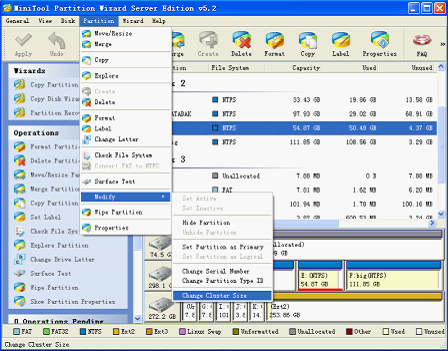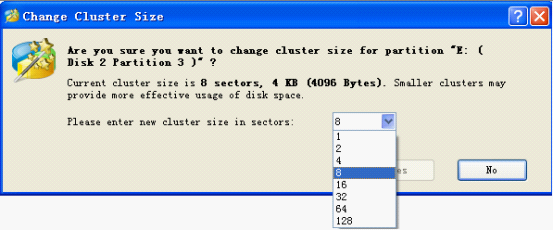Data Recovery -> Cluster
Storage devices
Types of HDD
Partition Series
Linux
Operating Systems
Windows
Cluster
Disk is composed of sectors and several sectors constitute a cluster. File access is in unit of cluster even this file is only 1 bit. Every cluster in FAT has a corresponding table entry and the cluster number is the table entry number. Every table entry takes up 1.5 bytes (disk space smaller than 10MB) or 2 bytes (disk space larger than 10MB).
Cluster instead of byte is the unit of disk space taken up by files. Usually, every cluster of floppy is a sector and sectors of a cluster in hard disk are related to the capacity of hard disk. So the number of cluster may be 4, 8, 16, 32, 64…… And the rest can be done in the same manner. Data of one file may not be stored in a continuous area in disk but be divided into several segments and stored like a chain. And this form of file store is called chain store. As link information (FAT) between segments is stored in disk, the system can always find the locations of segments and read it accurately when it reads files. In order to realize chain store, the disk must accurately record which cluster has been taken up and indicate the number of next cluster storing subsequent content for the clusters taken up. As to the last cluster of a file, the disk has to indicate that there is no subsequent cluster. And these are stored in FAT and FAT has many table entries that record information of every cluster. Because of the importance of FAT for file storage, FAT has a backup for safety, which means that another same FAT is built next to the original FAT. All table entries in the original FAT are marked with "untaken". But if the disk is damaged partly, the formatter will detect the damaged cluster and mark it with "damaged cluster" in the corresponding entry and this cluster will be not taken up in file access. The number of entries in FAT must be same as the total number of clusters in disk. And the number of bytes taken up by every entry must be compatible with the total number of clusters because cluster number is stored in table entry.
The sizes of all partitions in a disk are different and different partitions have different sizes of clusters. By using MiniTool Partition Wizard, users can rapidly know the size of cluster in a partition. Operate MiniTool Partition Wizard and chose the partition needing to look up, and click the menu bar Partition"->Modify ->Change Cluster Size:

Then the the size of clusters can be seen clearly in the picture.

The value of clusters is 8, which means every cluster has 8 sectors. Of course, the cluster size can be changed according to the size in combo box to meet the demand of different users. MiniTool Partition Wizard is a good choice for disk partition management.
Cluster instead of byte is the unit of disk space taken up by files. Usually, every cluster of floppy is a sector and sectors of a cluster in hard disk are related to the capacity of hard disk. So the number of cluster may be 4, 8, 16, 32, 64…… And the rest can be done in the same manner. Data of one file may not be stored in a continuous area in disk but be divided into several segments and stored like a chain. And this form of file store is called chain store. As link information (FAT) between segments is stored in disk, the system can always find the locations of segments and read it accurately when it reads files. In order to realize chain store, the disk must accurately record which cluster has been taken up and indicate the number of next cluster storing subsequent content for the clusters taken up. As to the last cluster of a file, the disk has to indicate that there is no subsequent cluster. And these are stored in FAT and FAT has many table entries that record information of every cluster. Because of the importance of FAT for file storage, FAT has a backup for safety, which means that another same FAT is built next to the original FAT. All table entries in the original FAT are marked with "untaken". But if the disk is damaged partly, the formatter will detect the damaged cluster and mark it with "damaged cluster" in the corresponding entry and this cluster will be not taken up in file access. The number of entries in FAT must be same as the total number of clusters in disk. And the number of bytes taken up by every entry must be compatible with the total number of clusters because cluster number is stored in table entry.
The sizes of all partitions in a disk are different and different partitions have different sizes of clusters. By using MiniTool Partition Wizard, users can rapidly know the size of cluster in a partition. Operate MiniTool Partition Wizard and chose the partition needing to look up, and click the menu bar Partition"->Modify ->Change Cluster Size:

Then the the size of clusters can be seen clearly in the picture.

The value of clusters is 8, which means every cluster has 8 sectors. Of course, the cluster size can be changed according to the size in combo box to meet the demand of different users. MiniTool Partition Wizard is a good choice for disk partition management.